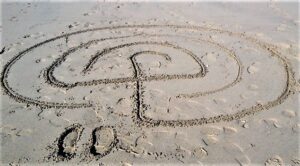
Labyrinths seems to be popping up everywhere I go at the moment! There are several very close to my home in Cornwall, so I thought I would share how I have been using this fascinating symbol to support my birth work.
Since ancient times, the labyrinth has been a powerful spiritual symbol for the journey we make through life, with its twists and turns representing the ordeals we go through and challenges we face. This universal symbol has been been found all over the world in various forms and in different cultures. It has been etched into rock faces, found in churches, on tombs and on pottery. It is deemed to be one of the oldest sacred symbols with the circle and spirals honouring Mother Earth, fertility and the divine feminine aspect.
Unlike a maze, a labyrinth has a single path so there is only one way in and one way out. When we journey through a labyrinth, we know that by putting one foot in front of the other, we will eventually get to the centre, a place of both endings and beginnings and by treading the same path we will eventually find our way out.
Labyrinths and Meditation
Labyrinths make a great meditative tool as by tracing or walking them our brain waves slow down taking us out of our ‘thinking’ logical brain into a more intuitive meditative flow space – in fact the space we find ourselves in during deep labour. The journey to the centre can represent letting go or a figurative ‘death’ and the journey back outwards, ‘birth’ and ‘rebirth’. As we spiral round, we can really let our mind wander with the twists and turns, releasing and letting go of our thoughts as we make our way to the centre and back out again.
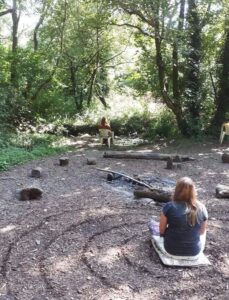
There is a long history of labyrinths being used in labour and birth around the world. In England and Cornwall, midwives and healers would etch a labyrinth onto a piece of slate, which they would then trace to drop into that deeper meditative state. In this more intuitive space, they would find guidance helping them to make decisions and support the people they work with. These slate labyrinths would then be passed down to an apprentice or would be buried with the elder midwife / healer when they died.
‘Laborinths’
Pam England in her beautiful book ‘Labyrinth of Birth’ describes how a labyrinth or ‘laborinth’ can be used as a map for the journey we make through pregnancy, labour and post-partum. The journey to the centre of the ‘laborinth’ represents labour, the centre the point you meet your baby and the journey out signifies our return and the post-partum period.
When you are in labour, there is nothing that you need to do other than wend your way slowly to the centre of the labyrinth to meet your baby. You may feel fear or doubt and that you are not making progress as you wind round and round its paths, but keep going, keep the faith, with each twist and turn you are getting nearer to meeting you baby.
When you reach the centre you are also at the beginning again, so rest a while in this space, before you prepare yourself to make your outward, postpartum journey.
Labyrinths for Birth Preparation
Since I have been training to become a Birthing From Within Childbirth Educator, I have been using labyrinths in my birth preparation sessions. Birth is a huge rite of passage and personal transformation and not merely an external or physiological experience. We can become so focused on assimilating external information that we can forget to give consideration to the inner journey we are making. The labyrinth is a wonderful tool to help us tap into that inner ‘knowing’ and orient ourselves in the space within.
Creating a Labyrinth
You can create a labyrinth on paper or even make a clay labyrinth like I did last year with a birth client as part of our preparation together. You might even be able to find one locally to walk round?
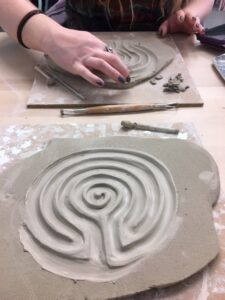
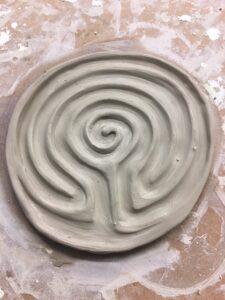

It’s a really therapeutic activity to do together and I always love to see how they turn out – everyone expresses themselves so differently. You can use them in your birth space during labour, or during pregnancy as a means of contemplation and meditation.
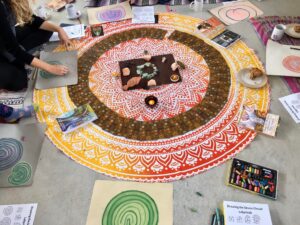
Labyrinths in Cornwall
We are lucky here in Cornwall as there are so many labyrinths to visit. This one below is near to Rocky Valley, Tintagel carved on the rock face of an old mill. There is some debate about its origins; some believe it dates back to the stone age, others think it is Celtic of origin, perhaps it is even more modern? Nonetheless, it is in a magical spot and well worth a visit.
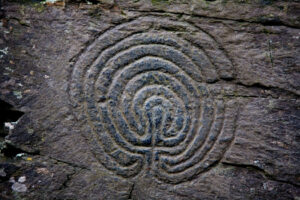
In Cornwall, on Bodmin Moor next to Colliford Lake an exciting new project is underway to build the world’s largest labyrinth ‘Kerdroyer’ (the Cornish word for ‘labyrinth’). This huge 56m diameter structure is being constructed from and as a homage to traditional Cornish hedges, which are made from a combination of stone and earth and are home to an abundance of wildlife. If you visit Cornwall, you will notice the beautiful high hedges along the lanes and they are particularly wonderful to see in Springtime.
Kerdroyer won’t be completed until 2023, but perhaps when it is, you would like to walk it with me?

Jo Kidman is an experienced mother of three children and lives in beautiful rural North Cornwall. She works as a birth and postnatal doula and is a Birthing From Within Childbirth Educator supporting families across Cornwall and the Devon border. More information about Jo’s offerings can be found here Cornwall Doula Services You can also find Jo on Doula UK Jo Kidman – Doula UK, Facebook Jo Kidman Doula Cornwall and instagram.